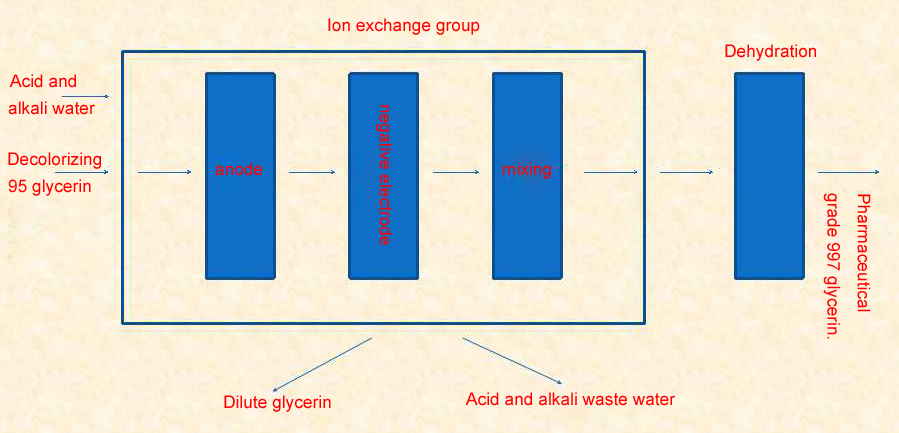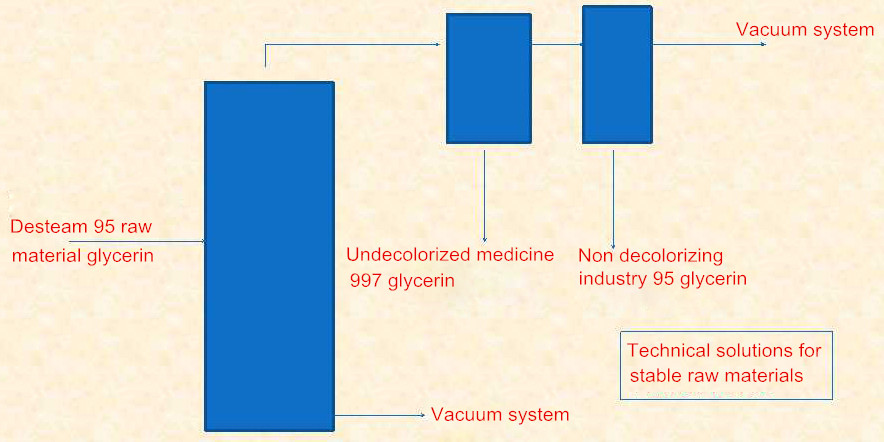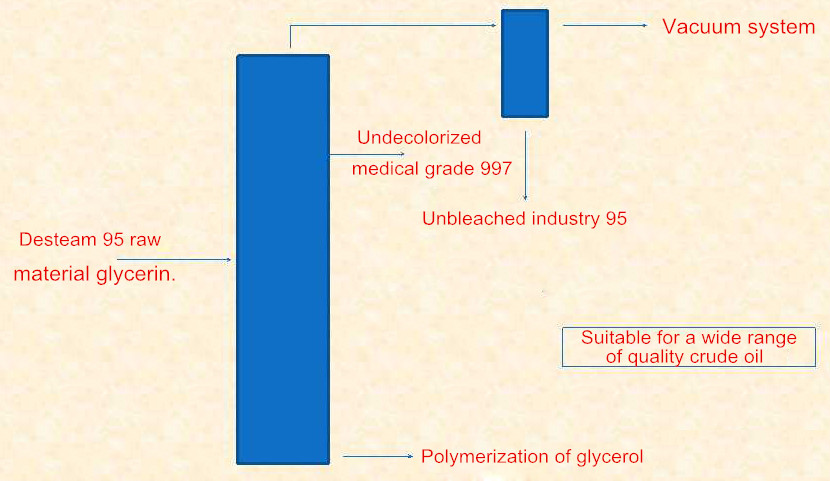The advantages and disadvantages of traditional ion exchange production 997 glycerol.
High Quality 995 Glycerol Technology
We have an advantage in the glycerine technology department:
Introduction to traditional ion exchange process

Advantage:
less investment, only half the route of the fine pavilion.
Faults:
Plan 1: Steam room + Temperature control condensation technology.

Plan 2: Side line discharging rectifying tower.

2014 Food grade glycerin standard
| Project | Index | Test Method |
| Glycerin content | 95.0-100.5 | GB/T13216 |
| Relative density(25℃/25℃) ≥ | 1.249 | GB/T50092 |
| Colour | Through tests | In the appendix A3 |
| Fatty acids and esters | Through tests | In the appendix A4 |
| Chloride w/% ≤ | 0.003 | In the appendix A5 |
| Readily Carbonizable Substance | Through tests | In the appendix A6 |
| ignition residue,w/% ≤ | 0.01 | GB/T13216 |
| lead (Pb)/(mg/kg) ≤ | 1 | GB 500912 |
2010 Edition Pharmacopoeia (1/4)
2010 Edition Pharmacopoeia (2/4)
2010 Edition Pharmacopoeia (3/4)
Diethylene glycol, ethylene glycol and other impurities Take this product about 10g, accurately weighed, set in a 20ml volumetric flask, precision added to the internal standard solution (containing 5ml of methanol solution of 0. 5mg of n-hexanol per 1ml, dissolved in methanol Diluted to the mark, as a test solution, take the appropriate amount of diethylene glycol, ethylene glycol, accurately weighed, dissolved and diluted with formaldehyde to make a solution containing 0.5 mg of diethylene glycol and ethylene glycol per 1 ml. Precisely placed 5 sold, placed in a 25ml volumetric flask, precision added to the internal standard solution 5ml, diluted with methanol to the mark, as a reference solution, another glycol, ethylene glycol, n-hexanol and glycerol amount, accurately weighed, Dissolve and dilute with methanol to prepare a solution that contains 400 mg of glycerin, 0.1 ml of diethylene glycol, ethylene glycol, and n-hexanol per 1 ml, as a system suitability test solution, according to gas chromatography (Appendix VE), ) Cyanopropylphenyl-(94%) Dimethicone is a capillary column for fixed solutions (or similar polar fixatives). The temperature is programmed and the initial temperature is 100°C for 4 minutes at 50 minutes per minute. The temperature of °C is increased to 120 °C, maintained for 10 minutes, and then 50 °C per minute Raise the temperature to 220 °C for 6 minutes; the inlet temperature is 200 °C, the detector temperature is 250 °C, take the system suitability test solution l, inject into the gas chromatograph, record the chromatogram, between the chromatographic peaks of each group The degree of separation should meet the requirements, and the reference standard sample should be used to repeat the sample injection. The relative standard deviation of the ratio of the peak area of the diethylene glycol and ethylene glycol to the peak area of the internal standard should not exceed 5%. The precise amount of the test solution should be 1μ1 in order. Into the gas chromatograph, record the chromatogram, according to the internal standard method to calculate the peak area, for the test products, diethylene glycol and ethylene glycol shall not exceed 0.025%: if there are other impurities peaks, deduct the internal standard peak by area According to chemical calculations, a single unknown impurity must not exceed 0.1%: the total amount of impurities (including diethylene glycol, ethylene glycol) must not exceed 1.0%.
